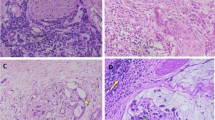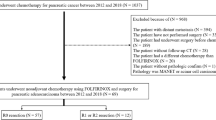Abstract
Objective
The aim of this study was to investigate the clinical relevance of the 8th edition of the Union for International Cancer Control classification of TNM staging for ampulla of Vater carcinoma (AC).
Methods
A total of 104 consecutive patients who underwent macroscopic curative resection for AC between January 2002 and September 2017 were investigated.
Results
Significant differences in recurrence-free survival (RFS) were found between T1a and T1b (p = 0.0030), but not between T1b and T2 (p = 0.9319), T2 and T3a (p = 0.0732), or T3a and T3b (p = 0.2118). The prognostic impact of the depth of duodenal invasion and pancreatic invasion, which define the T category, were evaluated. With regard to duodenal invasion, significant differences in RFS were found between the negative and submucosa classifications (p = 0.0012) and the muscularis propria and serosa classifications (p = 0.0131), but not between the submucosa and muscularis propria classifications (p = 0.6390). With regard to pancreatic invasion, significant differences in RFS were found between the negative and ≤ 0.5 cm classifications (p = 0.0001), and ≤ 0.5 cm and > 0.5 cm classifications (p = 0.0062). A Cox proportional hazard analysis for RFS revealed that duodenal invasion (submucosa or muscularis propria/negative, hazard ratio [HR] 5.08; serosa/negative, HR 7.42), and pancreatic invasion (≤ 0.5 cm/negative, HR 8.23; > 0.5 cm/negative, HR 9.81) were independent prognostic factors. An alternative new T category was proposed, based on the HRs, as follows: T1, tumor limited to the ampulla of Vater or sphincter of Oddi; T2, duodenal invasion (submucosa or muscularis propria); T3, pancreatic invasion (≤ 0.5 cm) or duodenal invasion (serosa); and T4, pancreatic invasion (> 0.5 cm). This alternative T category can well classify each subgroup with prognostic differences.
Conclusions
Reconsideration of the T category based on the prognostic impact of TNM factors, including the depth of duodenal and pancreatic invasion, are required in the 8th edition T category.


Similar content being viewed by others
References
Riall TS, Cameron JL, Lillemoe KD, et al. Resected periampullary adenocarcinoma: 5-year survivors and their 6- to 10-year follow-up. Surgery. 2006;140(5):764–772.
Bettschart V, Rahman MQ, Engelken FJ, Madhavan KK, Parks RW, Garden OJ. Presentation, treatment and outcome in patients with ampullary tumours. Br J Surg. 2004;91(12):1600–1607.
Inoue Y, Hayashi M, Hirokawa F, Egashira Y, Tanigawa N. Clinicopathological and operative factors for prognosis of carcinoma of the ampulla of vater. Hepato-Gastroenterology. 2012;59(117):1573–1576.
Jemal A, Siegel R, Ward E, et al. (2008) Cancer statistics. Cancer J Clin. 2008;58(2):71–96.
Albores-Saavedra J, Schwartz AM, Batich K, Henson DE. Cancers of the ampulla of vater: demographics, morphology, and survival based on 5625 cases from the SEER program. J Surg Oncol. 2009;100(7):598–605.
Kohga A, Yamamoto Y, Sano S, et al. Surgical strategy for T1 duodenal or ampullary carcinoma according to the depth of tumor invasion. Anticancer Res. 2017;37(9):5277–5283.
Maruyama K, Gunven P, Okabayashi K, Sasako M, Kinoshita T (1989) Lymph node metastases of gastric cancer. Ann Surg. 210(5):596–602.
You D, Heo J, Choi S, Choi D, Jang KT. Pathologic T1 subclassification of ampullary carcinoma with perisphincteric or duodenal submucosal invasion: Is it T1b? Arch Pathol Lab Med. 2014;138(8):1072–1076.
Kim SJ, An S, Kang HJ, et al. Validation of the eighth edition of the American Joint Committee on Cancer staging system for ampulla of Vater cancer. Surgery. 2018;163(5):1017–1079.
Alessandrino F, Ivanovic AM, Yee EU, Radulovic D, Souza D, Mortele KJ. MDCT and MRI of the ampulla of Vater. Abdom Imaging. 2015;40(8):3274–3291.
Chan C, Herrera MF, de la Garza L, et al. Clinical behavior and prognostic factors of periampullary adenocarcinoma. Ann Surg. 1995;222(5):632–637.
Adsay NV, Bagci P, Tajiri T, et al. Pathologic staging of pancreatic, ampullary, biliary, and gallbladder cancers: pitfalls and practical limitations of the current AJCC/UICC TNM staging system and opportunities for improvement. Semin Diagn Pathol. 2012;29(3):127–141.
Sakata J, Shirai Y, Wakai T, et al. Number of positive lymph nodes independently affects long-term survival after resection in patients with ampullary carcinoma. Eur J Surg Oncol. 2007;33(3):346–351.
Kanai M, Hatano E, Kobayashi S, et al. A multi-institution phase II study of gemcitabine/cisplatin/S-1 (GCS) combination chemotherapy for patients with advanced biliary tract cancer (KHBO 1002). Cancer Chemother Pharmacol. 2015;75(2):293–300.
Valle J, Wasan H, Palmer DH, et al. Cisplatin plus gemcitabine versus gemcitabine for biliary tract cancer. N Engl J Med. 2010;362(14):1273–1281.
Okusaka T, Nakachi K, Fukutomi A, et al. Gemcitabine alone or in combination with cisplatin in patients with biliary tract cancer: a comparative multicentre study in Japan. Br J Cancer. 2010;103(4):469–474.
Acknowledgment
The work is not based on any previous communications to a society or meeting.
Author information
Authors and Affiliations
Corresponding author
Ethics declarations
Conflict of interest
Taisuke Imamura, Yusuke Yamamoto, Teiichi Sugiura, Yukiyasu Okamura, Takaaki Ito, Ryo Ashida, Katsuhisa Ohgi, and Katsuhiko Uesaka declare that they have no conflicts of interest.
Disclosures
Taisuke Imamura, Yusuke Yamamoto, Teiichi Sugiura, Yukiyasu Okamura, Takaaki Ito, Ryo Ashida, Katsuhisa Ohgi, and Katsuhiko Uesaka affirm that they have no financial or personal affiliations (including research funding) or other involvement with any commercial organization that has a direct financial interest in any matter included in this work.
Additional information
Publisher's Note
Springer Nature remains neutral with regard to jurisdictional claims in published maps and institutional affiliations.
Electronic supplementary material
Below is the link to the electronic supplementary material.
Rights and permissions
About this article
Cite this article
Imamura, T., Yamamoto, Y., Sugiura, T. et al. The Prognostic Relevance of the New 8th Edition of the Union for International Cancer Control Classification of TNM Staging for Ampulla of Vater Carcinoma. Ann Surg Oncol 26, 1639–1648 (2019). https://doi.org/10.1245/s10434-019-07238-6
Received:
Published:
Issue Date:
DOI: https://doi.org/10.1245/s10434-019-07238-6




